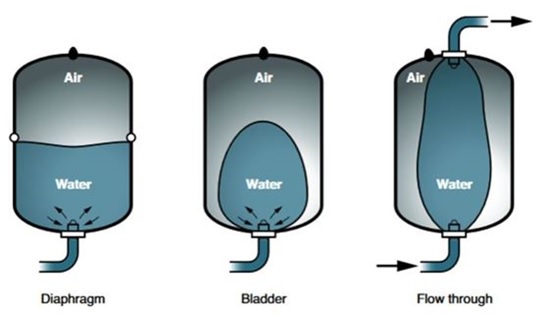Expansion vessels are an important integral part of pressurised hot and cold water systems, particularly in larger facilities such as hospitals.
They can also be referred to as pressure vessels or hydraulic accumulators.
Expansion vessels are designed to protect the water system infrastructure from damage caused by pressure build-up and pressure fluctuations.
And, when installed correctly and operating as designed, the volume of water within the vessel will fluctuate according to demand on the system, be it a hot or cold system, to negate the pressure issues associated with a boosted or mains supply feed to the system.
Background
The three main types of expansion vessels that are found in most, if not all, installations are diaphragm, bladder, and flow through as in the below illustration.
There are three main types of expansion vessel. Extracted from HSG274 Part 2
A Legionella risk assessment should identify the location and type of vessel(s) you have and make recommendations concerning Legionella proliferation mitigating measures.
The Water regulations guide R17.3 states that: “Some doubts have been expressed about the desirability of using single-entry expansion vessels.
“The use of single-entry expansion vessels effectively forms a vertical dead leg through which there is no flow of water and concern has been expressed about the possibility of bacterial growth within the vessel.
“It is considered preferable, therefore, that an expansion vessel with both inlet and outlet connections should be installed, wherever practicable so that the water content of the vessel is constantly changed.
“Where expansion water is accommodated separately the expansion vessel should be of an approved flow-through type and should comply with the requirements of BS 6144 and BS 6920.
Dead ends and dead legs
Some expansion vessels may have a rubber diaphragm that may be a source of nutrients for Legionella.
Diaphragm or bladder vessels (diaphragm or bladder vessels should meet BS 6920) that do not have regular flow through are often seen installed on lengths of pipe that do not allow water to move and the expansion vessel itself creates a dead end or dead leg.
With the combination of organic material, and the potential for low-flow areas, Legionella has the ideal conditions to grow and multiply.
To manage these types of vessels and the adjoining pipework, they must be flushed regularly in line with current guidance and your Legionella Risk Assessment.
So how can we minimise the risk of potential bacterial growth within our expansion vessels?
- Ensure they are installed correctly
- Avoiding water temperatures between 20˚C-45˚C
- Make sure they are manufactured from approved materials
- Ensure they are mounted vertically (the correct way up) on the pipework to minimise trapping any debris
- Ensure the vessel is fitted with an isolation valve and drain valve to aid flushing and sampling
- Mount them as close to the incoming water supply as possible
- Vessels must be installed exactly as per the manufacturer’s instructions
- They must be designed to minimise the volume retained within them
- Their design should be considered to achieve maximum flow through the vessel
- Flow-through vessels should be fitted where appropriate
- Regular checks should be made on the vessel to ensure it is operating correctly
HTM04-01 Part B Section 7.39 recommends: “Pressure and expansion vessels should be subject to routine inspection and maintenance as recommended by the manufacturer.
“These should be flushed through with wholesome water and purged to drain where practicable. If replaceable, bladders, or diaphragms should be changed according to the manufacturer’s guidelines.”

HSG274 Part 2 2.39 and Table 2.1 make the same recommendations as above from HTM0401 Part B.
Other considerations
 Some products currently available can be retrofitted to convert a standard single connection expansion vessel into a ‘flow through type’ by diverting a portion of the flow into the vessel so the water is continually renewed.
Some products currently available can be retrofitted to convert a standard single connection expansion vessel into a ‘flow through type’ by diverting a portion of the flow into the vessel so the water is continually renewed.
These are known as anti-Legionella valves, and if a WRAS-approved valve is used and installed correctly it can help mitigate potential stagnation.
Under the Health and Safety at Work Act 1974, and in compliance with ACoP L8, HSG 274, and HTM04-01, duty holders, including employers and those in control of premises, must identify any potential risk (this includes Legionella and other water-borne bacteria) and implement a control regime to protect their employees or others that may be affected.
And, as with any risk, the first consideration should be elimination.
Consider changing out old-style vessels with a suitably-sized alternative flow-through design.
This is usually relatively inexpensive to do, although the work should be carried out correctly, as per the manufacturer’s instructions, and in line with current Water Regulations.
ACOP L8 Para 78 states: “Anyone involved in the supply of water systems (designers, manufacturers, importers, suppliers, and installers) must, as far as is reasonably practicable, ensure the equipment is designed and constructed so that it is safe when used at work and enable safe and easy operation, cleaning, and maintenance.”
ACOP L8 Para 80 – b adds: “Aid safe operation (e.g. without dead legs, or if this is not possible, limit the length of dead legs and disconnect or remove redundant or non-essential standby plant.
In conclusion
Expansion vessels are an integral component of water distribution systems.
As discussed, there are various types, and each, on its own merits, may need different maintenance and Legionella management protocol.
When installed correctly, and serviced with an appropriate maintenance regime, the potential for the proliferation of Legionella bacteria within an expansion vessel can be greatly reduced.
